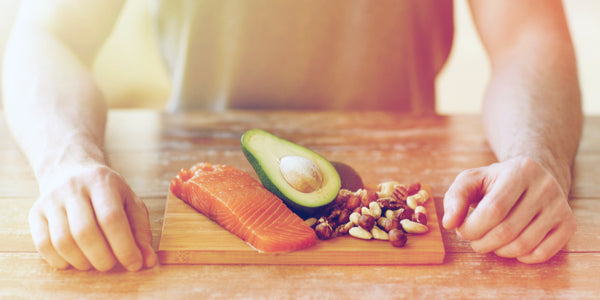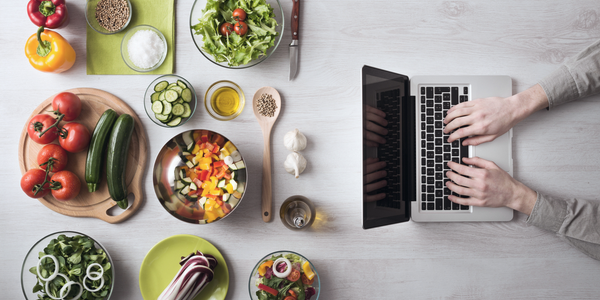
A paleo diet encourages one to eat like our ancestors, thousands of years ago. Having a hunter and gatherer mentality encourages whole foods such as meats, poultry, fish, and vegetables.
Most people take to the paleo diet for weight loss and other benefits. But does it truly live up to its current hype?
We are exploring a paleo diet definition and potential benefits and risks of this type of eating plan and pattern.
What Is the Paleo Diet?
Simply put, the Paleo diet is a dietary pattern encouraging its followers to "eat like a caveman." Which is not so coincidentally why it is also known as the "caveman" or primal diet.
At its core, paleo promotes a diet similar to the one consumed by our earliest ancestors. The idea is that eating meat, fruit, and other foods hunted and gathered is aligned with our genetics. And, therefore, this is the optimal eating plan for good health.
Despite its evolutionary past, paleo was popularized in current day by Dr. Loren Cordain. Author of The Paleo Diet, Cordain is claimed to be the "world’s foremost authority on the evolutionary basis of diet and disease."
Benefits of Going Paleo
As humans have evolved, so has the food industry. This has made more ultra-processed foods readily available and, in turn, growing rates of obesity and chronic diseases.
But, based on the basic guidelines of the Paleo diet, going back to our ancestors can reverse these risks. According to The Paleo Diet, adopting the paleo way of life may lead to the following health benefits:
• Reduce the risk of heart disease, type 2 diabetes, and most chronic degenerative diseases that affect people in the western world
• Lose weight if overweight
• Improve athletic performance
• Slow or reverse progression of an autoimmune disease
• Improve or eliminate acne
• Sleep better with more energy throughout the day
• Increase in libido
• Improve mental outlook and clarity
• Enjoy a longer, healthier, more active life
Paleo can also be beneficial for those managing celiac disease or gluten intolerance. Because with gluten-containing ingredients being "off-limits," including wheat, foods are coined as gluten-free.
Risks & Concerns of a Paleo Diet
Despite the proclaimed benefits, the paleo diet does raise some concerns. Some risks of going paleo may include:
• Nutrient deficiencies: The paleo diet eliminates a number of food groups, including whole grains and legumes which is detailed below. These complex carbs offer valuable nutrients such as fiber and B vitamins. Dairy products are also eliminated, which can substantially reduce calcium in the diet if not supplemented appropriately.
• Restrictive: Despite the appeal of weight loss, and if one does shed some weight, it may not be withheld for the long-term. Diets restrictive in nature tend to cause yo-yo dieting, which can be physically and mentally damaging. What’s more, going paleo can take the enjoyment away from social gatherings.
• Harmful: Though all can benefit from reducing carb intake from sugary products, particularly to lower the risks of insulin resistance and other health conditions, chronic low carb can be dangerous. This particularly serves true for those managing diabetes or other chronic diseases.
Paleo Diet Guidelines
The dominant diet guideline of the Paleo diet is eating like a hunter-gatherer and not like a farmer. This means eating and avoiding certain dietary sources, including some rich in nutrients.
Foods to Eat on Paleo Diet
On paleo, lean meat, fish, fruit, veggies, and healthy fats are abundant. More specific examples of acceptable paleo diet foods include:
• Meat & Poultry: Beef, bison, chicken, deer, turkey, veal, and pork. Choose grass-fed meat and leaner cuts whenever possible.
• Eggs: Look for cage-free eggs and prepare scrambled, hardboiled, etc.
• Seafood & Fish: Catfish, crab, haddock, oysters, shrimp, tilapia, and tuna. Wild-caught fish and seafood are encouraged.
• Fresh Fruit: Apples, avocados, bananas, berries, lemons, limes, pears, and plums. Select whole fruits over fruit juices.
• Fresh Veggies: All fresh varieties, including non-starchy and starchy veggies. These include, but are not limited to leafy greens, squashes, and cruciferous veggies.
• Nuts & Seeds: Almonds, Brazil nuts, cashews, chia seeds, flax seeds, pistachios, pecans, and pumpkin seeds. Their respective nut and seed butter are included, too.
• Fats & Oils: Avocado oil, butter, cacao, coconut oil, olive oil. Any animal fat is also permitted.
• Seasonings: All fresh and dried herbs and spices can help flavor Paleo-friendly foods. Basil, cinnamon, cumin, ginger, and turmeric are among the many seasonings to use in food prep.
• Natural Sweeteners: Coconut sugar, honey, and pure maple syrup.
• Drinks: Water, black coffee, unsweetened tea, and bone broth. Drinks without added sugar and artificial sweeteners are allowed, too.
Foods to Avoid on Paleo Diet
Eating like a caveman is not like eating like a farmer, which means avoiding dairy, grains, and legumes. Ultra-processed foods should likewise be avoided.
• Starchy Veggies: This includes regular potatoes and yucca. Some less strict versions of paleo allow sweet potatoes.
• Dairy & Dairy Products: Milk, cheese, yogurt, and cottage cheese.
• Beans & Legumes: No beans of any kind, including black, pinto, and kidney varieties. Since peanuts are also technically a legume, no peanut butter, either.
• Grains: Barley, corn, rice, rye, and wheat are just a few of the grains needed to be avoided when going paleo. This also means no bread, crackers, and products made with these grains.
• Processed Cooking Oils: This includes canola, corn, palm, and vegetable oils.
• Other Processed Foods & Ingredients: All artificial sweeteners, refined sugars, and processed meats such as deli meats. Avoid all packaged snacks and desserts, including chips and candy.
• Processed Drinks: No fruit juices, soft drinks, alcohol, and other sugary and processed drinks.
Paleo Diet Meal Plan
With various paleo diet rules and regulations, it may seem overwhelming on how to put it into everyday use.
We have simplified sample paleo meals and compiled a grocery list if the diet seems like a good fit for you.
Paleo Diet Menus
If following a Paleo diet, a 7-day paleo diet plan may look like something detailed below:
Day 1:
• Breakfast: Sautéed peppers and onions with cage-free scrambled eggs and a banana.
• Lunch: Tuna with celery stalks and cucumber slices.
• Dinner: Bison burger on portobello mushroom caps with a side salad dressed with olive oil.
Day 2:
• Breakfast: Hard boiled eggs with berries and nut butter.
• Lunch: Grilled chicken bowl with grated carrot, steamed broccoli, and cubed avocado.
• Dinner: Pulled pork with roasted asparagus and steamed apples spiced with cinnamon.
Day 3:
• Breakfast: Leftover pulled pork, eggs, and a piece of fruit.
• Lunch: Egg salad stuffed into lettuce leaves paired with a pear.
• Dinner: Beef and broccoli stuffed into a roasted sweet potato.
Day 4:
• Breakfast: Paleo chia seed pudding (recipe below), banana slices, blueberries, almonds, honey, and cinnamon.
• Lunch: Leftover steak atop a salad with an orange.
• Dinner: Red bell peppers stuffed with ground turkey and diced onion and tomato.
Day 5:
• Breakfast: Sweet potato topped with bacon crumbles and eggs over easy.
• Lunch: Chicken salad stuffed into an avocado.
• Dinner: Sirloin pan fried with coconut oil, peppers, and cabbage.
Day 6:
• Breakfast: Smoothie prepared with coconut milk, spinach, berries, and cinnamon.
• Lunch: Tuna cakes with sliced veggies.
• Dinner: Bibb lettuce wraps stuffed with grass-fed beef and mushrooms garnished with crushed cashews.
Day 7:
• Breakfast: Sautéed veggies with cage-free eggs.
• Lunch: Shrimp with broccoli, cabbage, and orange slices with slivered almonds.
• Dinner: Crunchy chicken tenders (recipe below) with spiralized zucchini dressed with tomatoes, olive oil, and favorite seasonings.
Simple Paleo Shopping List
Love the meal ideas above? Use this paleo shopping list to have the ingredients on hand. Also, feel free to purchase fresh or frozen, just be sure there are no added sugars, sauces, and other prohibited ingredients.
Meat, Fish, & Eggs:
• Bacon
• Bison
• Cage-free eggs
• Chicken tenders
• Grass-fed beef
• Ground turkey
• Pork
• Sirloin
• Shrimp
• Tuna canned in water without added salt
Produce:
• Apples
• Asparagus
• Avocados
• Bananas
• Berries
• Bibb lettuce
• Broccoli
• Cabbage
• Cucumbers
• Carrots
• Oranges
• Portobello mushrooms
• Spinach
• Sweet potatoes
• Zucchinis
Oils & Fats:
• Cashews
• Chia seeds
• Coconut milk, unsweetened
• Flax seeds
• Olive oil
• Slivered almonds
Seasonings & Sweeteners:
• Cayenne pepper
• Garlic powder
• Ground cinnamon
• Honey
• Onion powder
• Paprika
• Pure maple syrup
• Vanilla extract
How to Indulge on the Paleo Diet
Indulging on a paleo diet means getting creative in the kitchen with "on-limit" foods. While it does take a little more time and effort on your agenda, making paleo-friendly treats is not off the table.
Here are a couple ideas to get you started and inspired:
1. Paleo Chia Seed Pudding
Puddings are often dairy-based, making them forbidden on a paleo diet. However, this pudding recipe is a great alternative!
Ingredients:
• 1 cup of coconut milk
• 4 tablespoons of chia seeds
• 2 tablespoons pure maple syrup
• ¼ teaspoon vanilla extract
Directions:
1. Mix together the milk and chia seeds in a mason jar or other airtight container.
2. Let milk and seeds set for at least another 5 minutes then stir again to break up any clumps.
3. Add the remaining ingredients and stir until combined.
4. Place mixture in the fridge and allow to chill for at least 2 hours.
5. Top with paleo-friendly ingredients, including fresh blueberries, slivered almonds, and cinnamon.
2. Crunchy Chia Seed Chicken Tenders
Chicken is a high-protein staple, though eating it grilled may become boring day-in and day-out. And with most breadings off-limits, it is time to get creative.
Nuts and seeds can offer a favorable crunch and extra nutrients to chicken in this healthy paleo recipe!
Ingredients:
• ¾ cup flax seed
• ¼ cup chia seed
• 1 teaspoon garlic powder
• 1 teaspoon onion powder
• 1 teaspoon paprika
• ½ teaspoon cayenne pepper
• 1 egg
• 1 lb chicken tenders, skinless
Instructions:
1. Preheat oven to 400°F.
2. Add flax and chia seeds in a blender and mix until ground.
3. Add ground seeds and seasonings in a shallow bowl.
4. Crack egg into a separate shallow bowl and whisk.
5. One by one, dip each chicken tender into the egg until coated.
6. Dip egg-washed tender into the seed and spice mixture, making sure it is completely coated. Place tenders on a wire rack over a baking pan.
7. Bake for 20 minutes, flipping over the tenders after 10 minutes, until internal temperature reaches 165°F.







